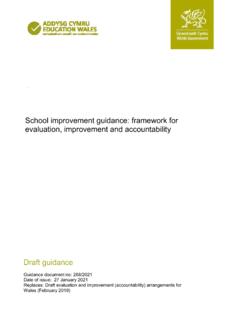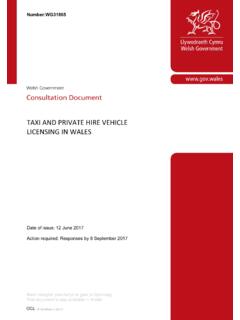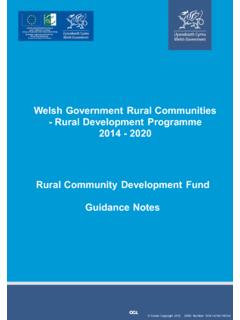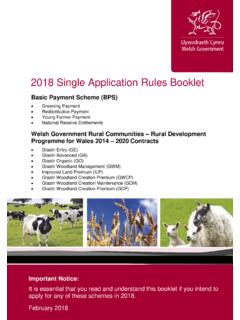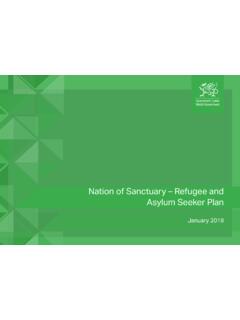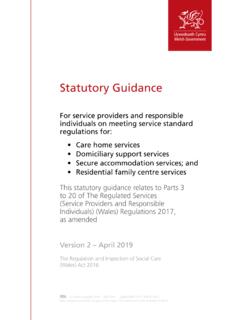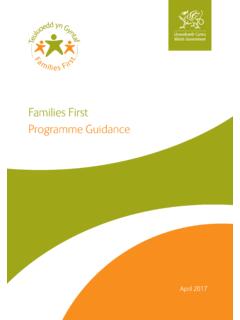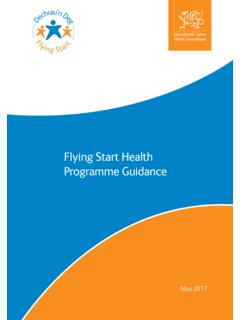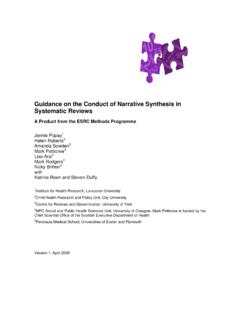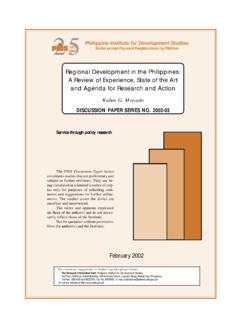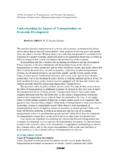Transcription of Site Context Analysis Guide - Home | GOV.WALES
1 Section 1 Setting the scene Important to read once The purpose of the Policy Site allocation & Vision & Site & Context Pre-application meetings & statutory obligations Section 2 Guidance Refer to when undertaking or reviewing site and Context Analysis Culture & Community Site location Planning Context Surrounding land & building use Neighbourhood structure Consultation & engagement Socio-economics Market Landscape Topography Green & blue infrastructure Ecology Ground conditions Movement & Infrastructure Road hierarchy & access Public transport Utilities & Built form urban form History & archaeology Building scale, height & density Building character & building traditionsSection 3 Informing Understanding Defining the development Refining the Test concepts & Site design Planning application Guidance for local planning authoritiesAppendix 1 Further reading Appendix 2 Analysis & presentation toolsCase Studies 1 Rural, edge of village2 urban infill3 Town centre plotContentsSite & Context Analysis Guide 010 Outline of the document The above diagram identifies stages in the design and planning process at which Analysis is relevant.
2 This Guide is structured around the stages of this process and you will find the diagram on each page to help in navigation through the stages you will encounter. Section 1 outlines considerations to be made in the stages leading up to site and Context Analysis . Section 2 of the document sets out an approach to site and Context Analysis and addresses the various aspects to be considered. Finally Section 3 focuses on how the Analysis informs a design framework, design proposals and planning application. The objectives of good design, as set out in national planning policy, should feed into an integrated Analysis and design process that includes pre-application meetings with the planning authority and consultation with the Design Commission for Wales at appropriate stages. When a planning application is made, it is important that the material submitted clearly and concisely communicates the site Analysis process and how it has informed the design.
3 This will assist the local authority in assessing the proposal and determining the application. This document is therefore relevant to applicants and their project teams as well as planners within local authorities. Good site and Context Analysis is a crucial step in achieving good design in the planning CONTEXTSITE ALLOCATION & SELECTIONVISION & BRIEFSITE ANALYSISPRE-APPLICATION MEETING(S)UNDERSTANDING FINDINGSFRAMEWORK PLANDESIGN/ PROPOSALSite & Context Analysis Guide 02 Section 11 Setting the scene Site Analysis is a critical part of the planning and design process. No development takes place in isolation - it will be influenced by the conditions of the site and will have an impact on its Context . Good site and Context Analysis forms the foundation of good design. The purpose of the Guide This Guide is relevant to those commissioning, undertaking and reviewing development proposals, and is relevant to developments of all types and scales.
4 It advocates a thorough, proportionate Analysis of a site and its Context as an integral part of the design process. The conclusions of the Analysis can be used to inform a design framework which, when combined with key urban design and architectural principles, will establish parameters for development. The result should be an approach that maximises the potential of the site and is presented clearly in a planning application. Design which is inappropriate in its Context , or which fails to grasp opportunities to enhance the character, quality and function of an area, should not be accepted, as these have detrimental effects on existing communities. TAN 12: Design, Welsh Government, para This document sets out an approach, endorsed by the Welsh Government and the Design Commission for Wales, for undertaking relevant and informative site Analysis to support all development proposals. Thorough Analysis will help to create the best value from the site and avoid expensive and abortive work.
5 The diagram in Figure 1 helps to illustrate the greater cost effectiveness of identifying features of the site and its Context that add value to the project at an early stage, whereas identifying constraints later on in the process provides little scope for adding value. Undertaking good site Analysis should lead to better quality design and a smoother planning process. Site & Context Analysis Guide 04 POLICY CONTEXTSITE ALLOCATION & SELECTIONVISION & BRIEFSITE ANALYSISPRE-APPLICATION MEETING(S)UNDERSTANDING FINDINGSFRAMEWORK PLANDESIGN/ PROPOSALFig 1. Cost/value graph shows how good site Analysis at an early stage in the design process can add value to a development, whereas identifying site constraints late in the process can be costly and cause delaysAmountTimeCost of changeScope for adding valueLate identification of a site constraintEarly site & Context Analysis and frameworkSite & Context Analysis Guide 05 Proposals informed by good site and Context Analysis can have many advantages including.
6 Better value the value of the site can be maximised through identification of its assets and potential Better environmental sustainability early consideration of climate, orientation and layout are essential to achieving environmental sustainability Better connectivity opportunities for well-planned routes, access to public transport and safe and enjoyable walking and cycling leading to more sustainable settlements Better accessibility early decisions are made to ensure that the development is accessible to all Better health and well-being - quality of life considerations can benefit residents and/or other users of the development Better sense of place maximising the use of existing features to give the development identity Better cost effectiveness - avoid abortive work and the cost of responding to constraints later in the process Better security - responding to the site Context will help to create a more secure development Good design makes everything CONTEXTSITE ALLOCATION & SELECTIONVISION & BRIEFSITE ANALYSISPRE-APPLICATION MEETING(S)
7 UNDERSTANDING FINDINGSFRAMEWORK PLANDESIGN/ PROPOSALFig 3. The design of Galeri overlooking Victoria Dock, Caernarfon has been inspired by its dock front location and the surrounding buildings. (c) Richard Murphy ArchitectsFig 4. Ysgol Craig y Deryn in Snowdonia has a strong relationship with the surrounding landscape which was a fundamental consideration in the design of the building in relation to its Context . (c) James MorrisSite & Context Analysis Guide 06 Fig 2. The Royal Welsh College of Music and Drama building in Cardiff utilises its water and park-side location to create an appealing external space. (c) Flanagan LawrencePOLICY CONTEXTSITE ALLOCATION & SELECTIONVISION & BRIEFSITE ANALYSISPRE-APPLICATION MEETING(S)UNDERSTANDING FINDINGSFRAMEWORK PLANDESIGN/ Policy Context The Welsh Government s objectives for good design in the built environment are set out in Planning Policy Wales and Technical Advice Note (TAN) 12: Design.
8 The latter identifies design as a process of Analysis and synthesis where issues are identified and solutions found through the design process. This Guide supports and elaborates on Chapter 4 of TAN 12 in relation to appraising Context . Local Development Plans (LDPs) and Supplementary Planning Guidance (SPG) provide more locally specific expectations and guidance. A review of local planning guidance should be undertaken as part of the Analysis process. This Guide is intended for use alongside the Welsh Government s Practice Guidance: Planning for Sustainable Buildings, which encourages early consideration of sustainability at the site Analysis stage. There are many publications, standards and guides which are helpful to refer to, and it is not the intention that this Guide repeats detail published elsewhere, rather relevant cross references are provided here in Section 2 to establish a clear link with existing guidance and literature.
9 Site Analysis will help in achieving performance levels required by Building Regulations and meeting broader sustainability and accessibility targets. The early identification of site constraints and opportunities, and an informed site layout will maximise sustainability, accessibility, security and value for & Context Analysis Guide 07 POLICY CONTEXTSITE ALLOCATION & SELECTIONVISION & BRIEFSITE ANALYSISPRE-APPLICATION MEETING(S)UNDERSTANDING FINDINGSFRAMEWORK PLANDESIGN/ PROPOSALSite & Context Analysis Guide Site allocation & selection Site selection is an important factor in the success of a development and for the sustainable growth of settlements. Identifying suitable sites for significant new development should be based on a sound Analysis of the Context at a settlement-wide scale. Analysis will help to establish how well the site is connected, the accessibility of facilities, and the capacity of the site.
10 The approach advocated in this Guide can help local authorities to review the opportunities and constraints presented by potential development sites in the LDP preparation and review process as well as to produce or review design briefs or masterplans for allocated sites (see section ). Similarly, developers considering alternative sites could benefit from reviewing the options against the factors highlighted in the following section of this document. The Analysis of sites at this stage should consider the opportunities presented by the site for the creation of a high quality, distinctive and sustainable development. Constraints should be analysed in light of opportunities, as good design is often generated by a creative response to CONTEXTSITE ALLOCATION & SELECTIONVISION & BRIEFSITE ANALYSISPRE-APPLICATION MEETING(S)UNDERSTANDING FINDINGSFRAMEWORK PLANDESIGN/ Vision & brief The importance of a project vision can at times be overlooked.
